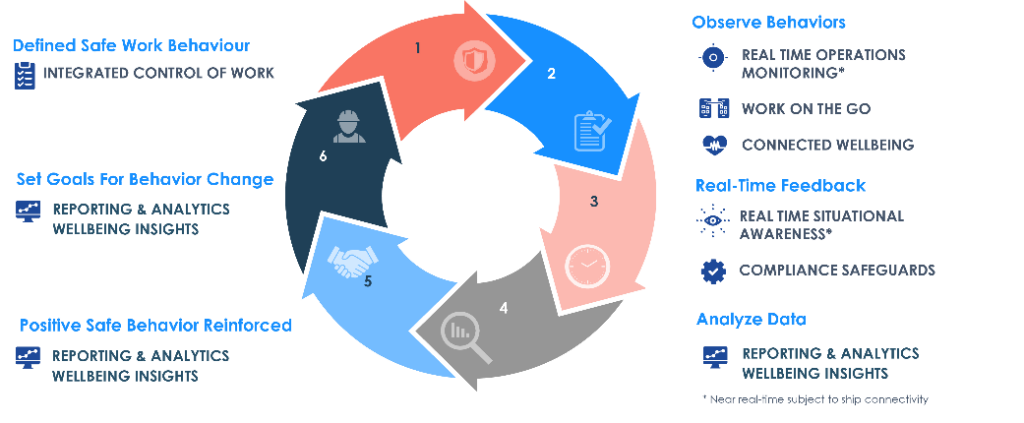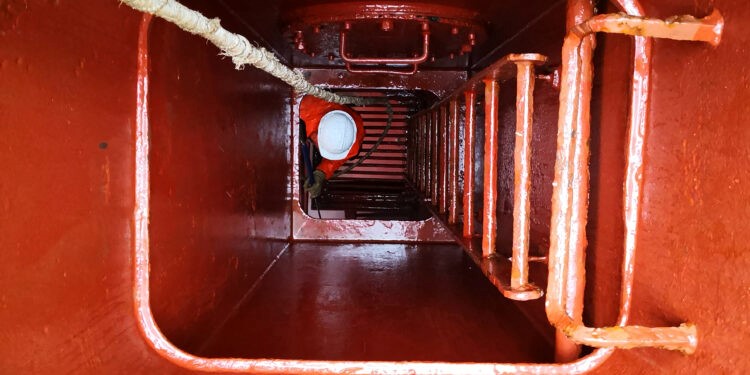The fatal danger associated with enclosed spaces is a major safety concern for hazardous industries such as shipping, oil and gas, chemicals etc. These industries are struggling to eliminate incidents despite the various new regulations introduced and control measures in place. Based on the USA market, from 2011 to 2018, 1,030 workers died from occupational injuries involving a confined space. The annual figures range from a low of 88 in 2012 to a high of 166 in 2017. This data is from the Bureau of Labor Statistics, Census of Fatal Occupational Injuries (CFOI). From this, we can estimate the number of deaths resulting from occupational injuries would be even more on a global scale.
What are some of the regulations at a glance?
- The Singapore Ministry of Manpower has created the Worksite Safety and Health (Confined Spaces) Regulations 2009, and this has come into operation on 1 November 2009. This includes training of workers and supervisors, implementation, and evaluation of confined space entry permit etc.
- With the Occupational Safety and Health Act of 1970, the US Congress created the Occupational Safety and Health Administration (OSHA) to ensure safe and healthful working conditions for workers by setting and enforcing standards. Many of OSHA standards require employers to provide personal protective equipment, ensure that workers safely enter confined spaces, and provide training for certain dangerous jobs.
- The International Safety Management (ISM) Code requires companies to ensure that proper risk assessment and procedures are in place to prevent such incidents.
- UK’s Maritime and Coastguard agency released MGN 659 (M+F) 2022, a regulation governing the entry in enclosed spaces.
Investigations into enclosed space-related casualties show that most are caused by poor training and knowledge of the correct entry procedures, or a disregard for them.
Findings of failures
What are some of the key issues that are often overlooked?
- Failure to recognise hazards of enclosed spaces
- Lack of awareness on the hazards of what is carried onboard
- Lack of understanding or non-compliance with company procedures
- Incorrect use of critical safety equipment
- Failure to carry out necessary safety precautions
- Unplanned and poorly executed rescue attempts
- Lack of intervention
In summary
A combination of both procedural non-compliance and human factors contributes to the risk of incident involving enclosed space. It is evident within the various hazardous industries on the need to have a digital approach in using IIoT technology to manage safety.
Human Factor
Most hazardous industries focus on Regulation and Procedure to improve safety. However, most investigations reveal that the incidents are related to the Human Element.
Benefits of IIoT to enhance end-to-end safety systems (with Human Factors incorporated)

IIoT and AI Technology – Smart Worksite and Connected Worker
There are available technologies in the market that can overcome the obstacles that are hindering the implementation of Human Factor elements to organizational safety systems. IIoT technologies and the Smart worksite concept has the potential to tackle obstacles addressed in the enclosed space entry incidents. Setting up Wi-Fi network connectivity or the usage of existing telecommunication means such as 5G on industrial workspace alongside with a comprehensive software and hardware solution that digitalize safety workflows and connect workers via wearable devices enables opportunities to improve visibility and compliance of work.
Connected Intrinsically Safe (IS) wearables and smart PTW systems can enable deadly hazards found in enclosed space to be better controlled, managed and information transfer more transparent across stakeholders.
i) Safe work practices are implemented as intended and safety culture is promoted within the organization (Defined Safe Work Behavior)
Digitalizing step-by-step workflows in the form of more intelligent PTW systems will streamline and improve compliance assurance. This will also lead to better planning and execution of tasks involving enclosed spaces. Further integration to the PTW, can include Detailed Risk Assessments (DRA), safety checklists, gas readings, Electrical Isolation Certificate (EIC) with remote office approvals and enclosed space monitoring.
Working hand in hand with connected wearables ensures compliance safeguards when the industrial worker is preparing a permit at key stages, such as DRA sign offs, checklist completion and EIC forms, where the user will be verified of his or her current location and time of signature. The roles and approval controls are also customized to different levels of authority for specific workflows, using unique worker identification.
The entire process ensures the right person is at the right place at the right time in ensuring that the enclosed space, for example, is safe for the task that is being planned for. There is proactive behaviour change as the worker is empowered to take ownership and accountability is assured for the tasks performed.
ii) Near real time operations monitoring (Observe Behaviors)
The Smart worksite connected platform using live dashboard enables near real time worksite wide visibility of front-line operations through its display of live worker location, identity and their active tasks with the information sent from individual workers’ wearables.
From real time operations monitoring, it also provides a holistic overview of cumulative risk and high-risk work activities. Responsible Authority will be alerted with worker assist notifications if workers happen to encounter difficulties in performing their tasks or are feeling unwell. Personnel that are near an enclosed space entrance will be highlighted on the dashboard for improved site identification and verification if they have the right credentials for entry.
This results in improved response, better workers communications and turnaround time on critical tasks. On the other hand, workers can perform on-site safety checks and permit documentation, and signoffs in offline mode with mobile approvals using their intrinsically safe devices. This enhances compliance, improves productivity and turnaround times by working anywhere on the worksite.
iii) Situational awareness of conditions on the ground, from the worker level up to the office personnel/fatigue management (Real Time Feedback)
With the availability of wearables for every worker, crucial information with regards to the working conditions, hazard exposure periods, and other work-related hazards faced by the workers for enclosed spaces and other work locations can be detected.
Persons with authority can remediate immediately at any point of time whenever he or she reviews the current situation or trends emerging. The information therein be made accessible for persons in the organization across the hierarchy. This includes empowering the workers themselves in performing their own preventive actions when they are being alerted of a dangerous situation.
It also reinforces positive behaviour, for example, when the workers are exposed to heat stress environment with alerts to notify them to hydrate and take short breaks as needed. Workers often get engrossed with their task so this could also be a good tool to break the monotonous routine and carry out Take-Five. Together with real-time interventions like geofence alerts which the workers can receive on their wearables while approaching near hazardous zones, they can take the necessary actions within good time.
iv) Ensured quality of data for information that is gathered from the connected wearables and smart PTWs (Analyze Data)
With near instantaneous information transfer of Control Of Work inputs and the conditions the workers face in the worksite, data for formulating safety programs can be ensured that they are of good quality. This can help the organization in having confidence that their targeted safety programs are based on sound observational data sets.
In addition, active sensors on the wearable enables capture of workers insights and leading indicators that bring about better efficacy of corporate wellness programs and health and safety plans. This information empowers workers with near real time data to manage immediate risks when the wearable monitors workers safety and wellbeing through important health signals, notifications, and recommendations.
v) Ready-made analytics and possible solutions for organizational usage, backed by an experienced team of Safety Personnel and AI (Positive Safe Behavior Reinforced/Set Goals For Behavior Change)
From the data gathered from observations on the ground enabled via smart PTWs and connected wearables, actionable insights can be taken into the possible underlying root causes to issues that are being identified.
There can also be continuous updates of Risk Assessment. Newly added hazards and measures related to all Enclosed Space Entry Permits can be identified and then updated in a centralized database that can be shared across all.
For enclosed space entries, insights include:
– Location Mismatches: are safety checks being conducted on site?
– Missing Gas Readings
– Missing sign offs
– Isolation Certificates (lock out for life)
– Extended entries – duration of each entry: are workers spending too long inside an Enclosed Space?
These insights can also be used for standardization and sharing of best practices, and leading indicators for continuous improvements such as benchmarking high-risk activities like enclosed space, time spent preparing and executing permits. Organizations can then pinpoint in a more efficient and faster manner to tackle issues that plague enclosed space entries and other hazardous activities that can impact the safety performance and try to aim for compliance towards zero incidents.
Training, education, and drills
As outlined in the OSHA regulations and others, there is a need to train the workers so that they know the dangers around enclosed space entry and what they should do in specific situations. There is also the requirement to educate for the unknown, making sure that workers perceive and react to risks in ways which can protect them and their colleagues. This needs to be addressed through formal training and regular drills.
By leveraging the Control Of Work data and analytics derived from connected worksites as mentioned above, training content can be made specifically to target topics that are of the most concern on the worksites such as lack of procedural compliance.
With analytics, organizations can then pinpoint in a more efficient and faster manner to tackle issues that plague enclosed space entries and other hazardous activities that can impact the safety performance and try to aim for compliance towards zero incidents.
Regular drills and actual rescue operations related to entry into enclosed spaces can be further enhanced and more effectively run through a smart worksite environment that supports location tracking of workers and provides near real-time visibility of the time critical operations.
Personal Protective Equipment (PPE)/Equipment
Finally, for every enclosed space, there should be gas metering equipment and every worker be equipped with a gas detection software system.
Through a digitalized PTW system, safety checklist questions relating to enclosed space entry and worker’s answers to these can be analyzed to understand if correct procedures are being followed through on the ground. The smart PTW will allow users to take pictures directly from their mobile intrinsically safe devices to attach to the digital documents for verification of the site situation. For example, the proper application of PPE for an enclosed space entry can be validated by workers taking photos and attaching them to the digital safety forms, to provide evidence of correct procedure being followed at site.
A new safety era beckons
Hazards of enclosed spaces is but one of the many issues that continues to afflict the high-risk industries in terms of the number of incidents and casualties. In summary, current technology has the solutions that empowers organizations to take the necessary steps in improving the safety conditions and practices of, not only enclosed spaces, but across all activities and levels via metrics that are being measured and accessible in real time. Overtime, the workers will be empowered, trained, and inclined to be safe as this becomes a new normal.
SOL-X is a leading IIoT safety technology company centered on human factors. As an innovative start-up, we provide game changing technology with compelling benefits. These include improved operational excellence which brings about timing savings of 50% for Control Of Work planning, execution, and turn-around, enhanced safety by reducing cumulative risk, improving worker situational awareness and more. Visit us at https://www.sol-x.co. For enquiries, please contact us at contact@sol-x.co
